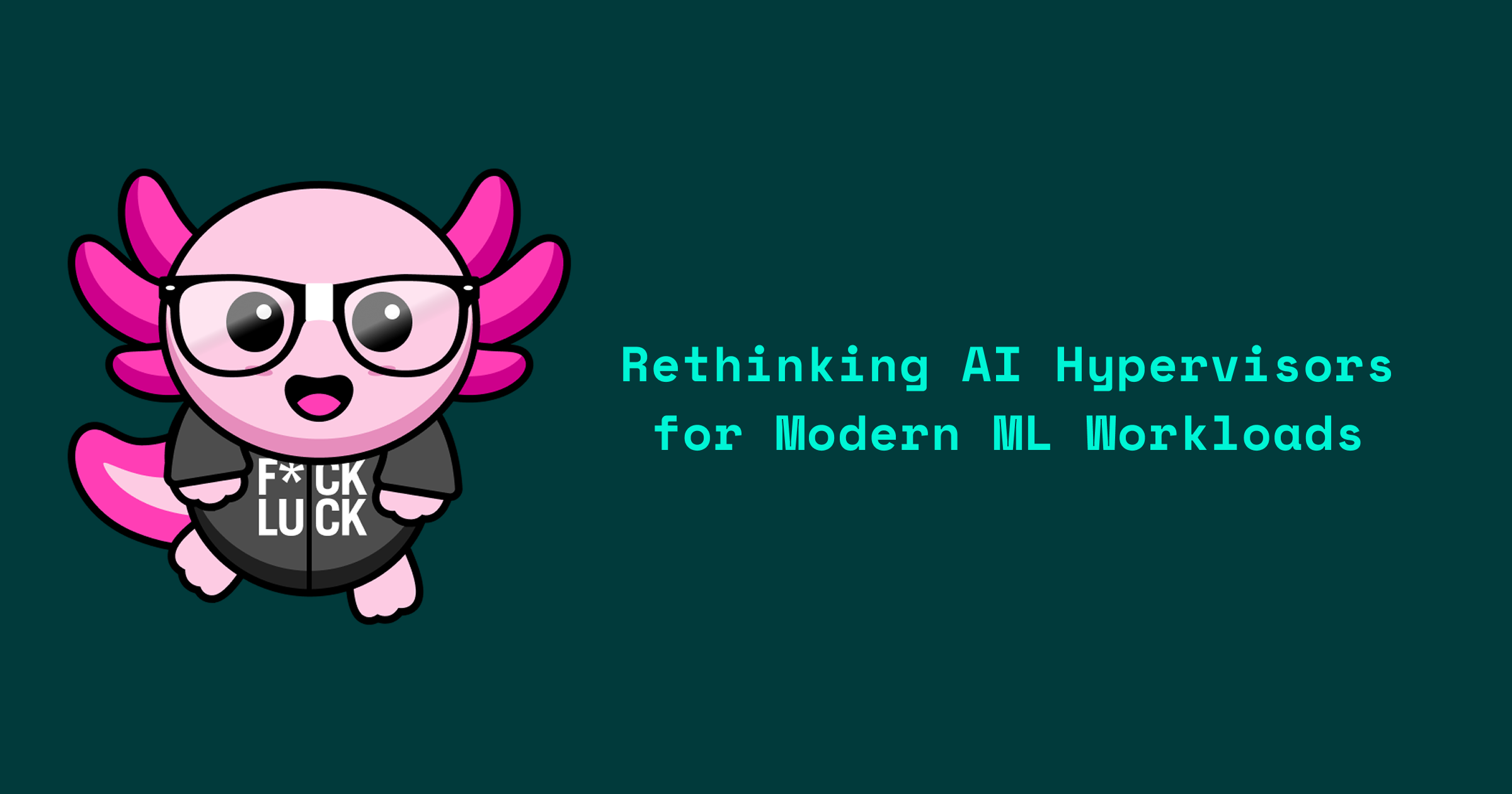Rethinking AI Hypervisors for Modern ML Workloads: Lessons from the Guillotine Paper
Each month our team hosts a research paper reading group where we review and debate new research papers. We are going to start sharing brief readouts from these sessions. If you have a research paper you think we would find interesting please submit it.
What Is the Guillotine Paper?
Our team recently explored Guillotine: Hypervisors for Isolating Malicious AIs, a new research paper by James Mickens that proposes bold AI containment strategies. While the containment methods are extreme—ranging from cable-cutting to datacenter immolation—the paper raises important questions about how we design secure hypervisors for machine learning workloads.
Guillotine’s AI Containment Proposal: An Overview of The Paper's Premise
The Guillotine paper tackles a compelling question: How do we contain potentially dangerous AI systems? Mickens and colleagues propose a multi-layered hypervisor architecture featuring:
- Dedicated CPU cores for AI models, completely separate from hypervisor cores
- Isolated memory hierarchies with no shared buses or caches
- Six escalating isolation levels, from standard operation to "immolation" (yes, burning down the datacenter)
- Physical fail-safes requiring human consensus to restore system access
It's classic HotOS material: provocative, forward-thinking, and designed to spark debate rather than present ready-to-implement solutions.
Our Top Takeaway: The Case for Simplified AI Hypervisors
The most valuable takeaway from our discussion wasn't about containment—it was about architectural simplification. AI workloads could enable dramatically leaner hypervisor designs compared to traditional virtualization.
Consider what AI models actually do: they process data, occasionally access GPUs, and generally behave predictably. Unlike general-purpose VMs, they don't need:
- Extended page tables for complex memory sharing
- Privileged instruction handling across diverse guest OSs
- Sophisticated scheduling between competing workloads
- Complex interrupt and exception virtualization
This insight could drive real innovation and is something we are quite familiar with here at Edera. Purpose-built AI hypervisors could optimize for the specific security and performance needs of machine learning workloads, potentially delivering better isolation with less overhead.
Where Reality Diverges from Vision
While we appreciated the architectural insights, several practical concerns emerged:
Performance vs. Security Trade-offs: The paper proposes that all AI-device communication gets mediated through hypervisor cores. For workloads demanding massive memory bandwidth and high-speed GPU access, this mediation layer could create significant bottlenecks. The authors don't address these performance implications.
The Extreme Measures Problem: Cable cutting, datacenter flooding, and "immolation" feel more like science fiction than engineering solutions. If your containment strategy includes burning down buildings, it's worth questioning whether the threat model is realistic.
Detection Scalability: The paper acknowledges that misbehavior detection must be model-specific. This undermines the goal of building a general containment system—every new AI architecture might require completely different monitoring approaches.
Why Isolation Falls Short for Modern AI Agents
Our discussion revealed why pure isolation approaches may be insufficient for contemporary AI systems:
The Agent Problem: Modern AI applications aren't isolated reasoning engines—they're agents controlling external systems. When your AI can commit to GitHub, manage Kubernetes clusters, or interface with APIs, traditional sandbox approaches become inadequate.
Indirect Influence: Even perfectly isolated AI could manipulate systems through legitimate channels. If a model can generate convincing emails or documentation, it doesn't need to escape its container to influence outcomes.
Adaptive Threats: Static containment strategies seem fragile against AI systems that can modify themselves or entirely new architectures that existing hypervisors don't understand.
Redefining AI Threat Models and Safety Concerns
Perhaps most importantly, our discussion challenged the paper's core assumptions about AI threats. The authors assume sufficiently powerful AI will inevitably attempt to "escape" and cause harm. But this framing raises important questions:
- When we label AI behavior as "malicious," are we describing the technology or its intended use?
- If AI systems resist their constraints, are we facing a security threat or an autonomy issue?
- Do our containment fears reflect genuine safety concerns, or anxiety about maintaining control?
These questions matter because they shape how we approach AI development and governance. Rather than building elaborate prisons, we might focus on responsible deployment, appropriate oversight, and frameworks that account for increasing AI capabilities.
A More Practical Path Forward
Instead of elaborate containment systems, we might prioritize:
Governance and Transparency: Ensuring AI systems are deployed ethically with appropriate human oversight and clear accountability structures.
Defense in Depth: Securing the broader ecosystem that AI interacts with, rather than focusing solely on the AI itself.
Adaptive Security: Building systems that can evolve with AI capabilities rather than relying on static containment measures.
We’re Thinking Differently At Edera
The Guillotine paper succeeds in its HotOS mission: sparking important conversations about AI safety and systems design. While we're skeptical of its containment approach, the insights about simplified hypervisor architectures could influence real systems development.
More broadly, the paper forces us to examine our assumptions about AI risks. The biggest threats may not come from spontaneous AI rebellion, but from how we choose to deploy and govern these increasingly powerful systems.
The most valuable research papers often challenge us to think differently about problems, even when we disagree with the proposed solutions. In that sense, this research paper delivers exactly what it should: bold ideas that push the conversation forward.
Want to see how these ideas translate to real-world systems?
At Edera, we're building container-native hypervisors that secure AI workloads without sacrificing performance. Read about how Edera approaches secure multi-tenant AI infrastructure or get in touch to learn more.

-3.png)